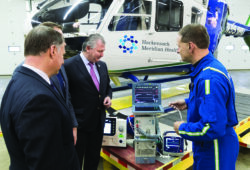There has been a fundamental shift in the focal point of healthcare innovation. Historically, innovation has been driven by the advancement of technology. The escalation of mass production and the chemical revolution post-World War II brought a number of improvements to healthcare, including inexpensive and effective antibiotics.
In the 1960s, the information technology revolution began, gradually digitizing healthcare over the next 40 years. From CT scanners to imaging guidance and robotics for interventions, advances in technology often created an immediate need for providers to acquire and implement the advancement in order to remain current and competitive. Their reaction to the seemingly unending stream of new options was to consume technology-based innovation in bulk. As time passed, costs increased, but those costs were passed along to employers, insurance companies and the government.
Today, healthcare providers face an ultimatum from the market: Choose to reduce costs on their own terms, or wait and be forced to do so. Consequently, the focus of innovation in healthcare has shifted from technology advancement to process improvement. The meaningful innovations in healthcare today are not produced by suppliers and reactively adopted by providers. Instead, providers are originating care delivery, process improvement and risk management innovations, while engaging strategic suppliers to determine their ability to support process innovation.
For example, providers are transforming the way populations receive healthcare with old technology like telephony and remote monitoring using basic Internet networks. Providers are also innovating how disease states are managed in multiple care settings in order to maximize the use of resources.
Other innovations are ensuring that care can be delivered in a satisfying and engaging way for patients, such as using free Internet videoconferencing software to connect with a care manager in the emergency department if a child is experiencing a potential medical crisis. In the case of chronic diseases, providers have spurred innovation by avoiding utilization of expensive services and managing clinical and financial risk while improving outcomes and satisfaction.
This shift from supplier- to provider-driven innovation coincided with the beginning of the global financial crisis in 2007, which caused many health systems to immediately reduce spending, redouble value analysis efforts and scrutinize purchasing decisions. The transformation of U.S. healthcare from volume- to value-based incentives in 2012 further accelerated the change, creating a series of challenges for both providers and suppliers.
Provider Challenges
1. Integration. Various technology platforms—all with different usage conditions, maintenance requirements and replacement lifecycle terms—require diligent monitoring and contingency planning. Integrating disparate systems is a perpetual challenge for executives and managers.
2. Standardization. One of the most reliable remedies for process variation is the use of standardized technology, particularly their protocols and procedures. Because healthcare delivery is contingent on physician input, implementing standardized protocols and procedures does not always happen without extensive review of the ways they conserve clinical judgment. Standardizing devices, services and equipment is a long-term project with multiple contingencies that must be managed.
3. Engagement. The most difficult challenge to any process improvement initiative is human behavior. Physicians need to be engaged and their perspectives and recommendations sought. Employees are the pivot point for organizational change. Most crucially, patients and their caregivers must be part of the equation. To achieve disease state management in multiple settings, families and patients must shoulder part of the care delivery burden. Doing this with standard tools is emerging as a priority for many facilities.
Supplier Challenges
1. Value. There is an apparent value gap in most .supplier-provider interactions. Bringing equipment, supplies, devices and drugs into an innovative, value-oriented organization requires a lot of skill and ability on the part of the sales and marketing teams. Furthermore, many health systems are required to deliver cost savings to their managers and boards. Therefore, they or their GPOs of record ask suppliers to demonstrate value either through compelling clinical capabilities and efficiency, and/or through dramatic and long-term price reductions. This conflicts with many supplier companies’ expectations that reform would increase utilization and demand at stable or increasing price points.
2. Market Share. Manufacturers monitor market share as a No. 1 determiner of commercial success. But in the value-based market of today, structural elements like accountable care organizations (ACOs) and bundled payment plans undermine the ability to grow case volume. Instead, ACOs and health systems are seeking ways to minimize expensive interventions and increased utilization.
3. Actions. How to engage in a meaningful discussion with a provider organization remains a conundrum for many suppliers. Some have developed and promoted “risk-sharing” agreements, but most have not been able to make any breakthroughs in new contract forms. Suppliers are struggling to know how to behave in a value-based marketplace.
Supply chain managers’ first job is to ensure that high-value relationships and supplier portfolios are maintained. In the coming years, it is reasonable to expect that more enterprise risk management will be required, and enlightened managers can look toward options that uniquely solve the provider/supplier challenges. In this way, supply chain management processes will be innovated.
The Role of GPOs
Because of their position in the marketplace, GPOs are a hub of innovation. HealthTrust has a strong record of fostering collaboration and innovative solutions to some of providers’ most difficult problems. From documented savings in commodities and supplies, to providing affordable access to emerging technologies to its members, HealthTrust serves the needs of both providers and suppliers as they seek to innovate in today’s new normal.
Share Email





